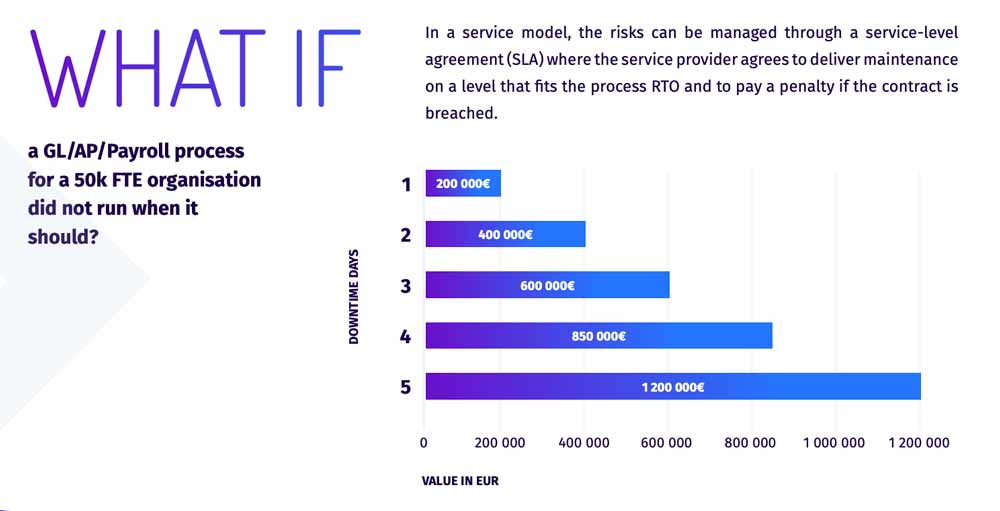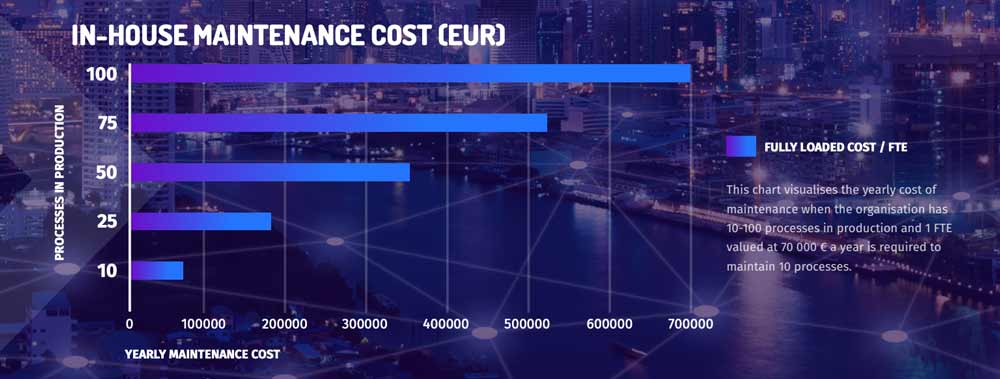
Securing business continuity with RPA Maintenance
Read below about securing business continuity with RPA maintenance.
Find a full guide to setting up a world-class RPA maintenance here.
Many organizations experience periods where resourcing enough people to perform even the most business-critical tasks becomes a challenge. This may be due to multiple things, such as vacations, the introduction of new IT systems, sick-leaves, key staff members switching jobs, and many other reasons. Also during this exceptional time, when many business processes are greatly disrupted by the corona outbreak, securing business continuity has become an important motivation to implement robotics.
Robotic Process Automation (RPA) can help in two ways to secure business continuity when staff fluctuations occur:
- improve business flexibility by alleviating pressure on staff and freeing uptime
- maximize the ability to run processes without the need for human intervention.
However, just having automations in place isn’t enough. The digital workers also HAVE TO keep running; if they fail to do so, they will not create value to the business or provide added security.
RPA tends to require significant amounts of runtime maintenance. Those familiar with robots have all seen how they crash, need new scheduling, or situations where the target system fails to launch calling for incident and problem management. The need for maintaining RPA doesn’t take into account vacation plans or other resource gaps: Inconvenient as it is, the same effort needs to be put into the robots as any other time.
A readily available maintenance organization is needed through the year, and under all circumstances, to ensure the digital workers operate smoothly – especially when there are business-critical processes in production.
Some topics need to be considered when deciding how to set up your RPA maintenance:
1. Capacity
The number of processes that one maintenance specialist is able to handle is related to, e.g., the complexity of the automations, quality of the build, and criticality of the process. At early stages, the amount of personnel needed is typically 1 FTE for 5-10 processes. As the processes get more stable and the organization more mature, 1 FTE is likely to maintain a somewhat larger amount of automations.
As personnel always have absences in the form of sickness, training and the very actual vacation season, the maintenance organization’s size should be set up so that the operations don’t suffer, and the automations stay up and running regardless of these fluctuations.
2. Scalability
A well-organized RPA Delivery team with a good pipeline typically delivers 1-3 automations to production per developer each quarter. With a delivery team of 4 developers up to 50 automations are deployed in a year. This rate of growth requires the maintenance organization to be scaled up from 1 to 5 FTE’s at the same time to keep up to the task of maintaining RPA.
3. Competence
Most RPA incidents can be identified and resolved by investigating logs as the incidents are typically related to changes in target applications. Updating the RPA application modeler to get the solution running does not require in-depth knowledge of the target process but demands strong experience in the automation technology in use. In fact, the maintenance specialists should be among the most experienced developers in the organization; this requires training in the chosen technology and extensive experience in developing automations.
4. Maintenance in the delivery team
Maintaining the solutions in the delivery team is a valid way of handling maintenance needs but also has a significant weakness. If developers tend to transform into full-time RPA maintainers when they have deployed 5-10 solutions to production, this hinders the progress of the whole program. Scaling up the solution and hitting targets slows down and the entire thing can come to a stand-still. The situation can be quite costly as the most significant benefits of RPA are linked to volume and using the technology on an industrial scale. Additionally, heavily relying on a small team of developers to also run processes can quickly hinder business when key staff members take time off or switch jobs.
5. Costs
The digital workforce is only creating value when the robots are working as intended. If your organization has an automated process pool of 100 FTE’s and the yearly fully-loaded cost of an FTE is 70 000 €, the impact of all processes being down for 1 day each month is potentially 230137€ (3,29 FTE).
Other downtime costs can also be related to mission-criticality: significant additional costs may result from business impact consequences such as losing a client, sanctions for failing to keep to service terms, delays to production, etc.

Looking at the cost of downtime, it is clear that setting up effective maintenance is required for productive automations. The maintenance function should aim to continuously improve the solutions to add to the automation-level of business processes and minimize downtime. Setting up, running, and growing an in-house maintenance team, however, also has its costs.
As stated in the beginning, 10 processes in production usually require 1 full-time maintenance specialist. The following chart visualizes the growth of running cost for a maintenance organization that is being scaled up to maintain 10, 25, 50, 75, or 100 processes in production. Bear in mind that on top of these numbers, you must consider training, recruitment, 24/7 rotation, sick leaves, vacations, etc.

This chart visualizes the yearly cost of maintenance when the organization has 10-100 processes in production and 1 FTE valued at 70 000 € a year is required to maintain 10 processes.
Costs can also be related to the mission-criticalness of a process; meaning that process A may carry a much greater cost than process B for being down over a weekend. Significant additional costs may result from downtime consequences such as losing a client, sanctions for failing to keep to service terms, putting production behind, etc.
When planning the maintenance of your RPA solutions, I recommend considering the following:
- Do you have business-critical solutions in production?
- Are the business-critical solutions running in the night-time?
- Do you have enough competence in your chosen RPA technology to deliver maintenance 24/7 and under any circumstances?
6. Outsourcing
The purpose of an RPA maintenance outsourcing service like Digital Workforce’s Run Management is to tackle the challenges mentioned above. Our service enables our customers to collect maximum benefits from RPA, focus on executing their digital strategy, and ensures business continuity under any circumstances by securing the 24/7 operation of the solutions in production. We are also continually improving the solutions which add to uptime and optimize processes to shorten their transaction time.
RUN Management also makes the cost of RPA maintenance transparent and helps to mitigate downtime risks related to automated processes. The customer can decide the priority of each process as part of the service, which affects e.g., the SLA. The service follows ISO20000 guidelines, includes quality acceptance, automated monitoring, making standard changes to processes, and managing and updating schedules.
Find a full guide to setting up a world-class RPA maintenance here.
Digital Workforce is a leading service provider specializing in Intelligent Automation (IA) services on an industrial scale. We offer a full suite of services, tools, and insights to support your journey through the intelligent automation life-cycle. Our cloud service is the easiest way to build an industrialized automation solution that grows flexibly with your organization’s needs. Our RPA maintenance service also ensures that you tap into the full benefits of your automations as your robots run smoothly 24/7/365.
We offer services in the world’s leading RPA technologies, Blue Prism, UiPath, and Automation Anywhere, and build AI solutions for our customer’s around the globe.